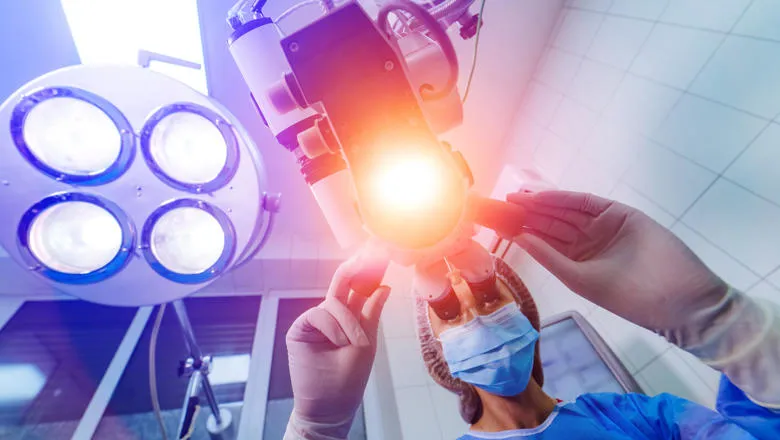This robot gives you a much better view when you do orbital surgery which is crucial when operating in very difficult to access areas, and in this particular instance in the orbital cavity. We are also close to vital structures like the eye and the optic nerve, and we obviously want to preserve these structures.
Jean-Pierre Jeannon Consultant ENT – Head & Neck surgeon at Guy’s and St Thomas’ NHS Foundation Trust & Honorary Associate Professor in Head & Neck Surgery
03 June 2021
New surgical robotic technology has led to a world-first non-invasive removal of an orbital tumor
The robot gives a much better view during orbital surgery which is crucial when operating in very difficult to access areas.

Removal of an orbital tumor type of surgery normally involve the removal of the eye, but a novel ground-breaking surgery was made possible by surgeons using the daVinci Xi robot to remove the tumor safely, preserving the patient’s vision and eye.
This project was led by led by Jean-Pierre Jeannon Consultant ENT – Head & Neck surgeon at Guy’s and St Thomas’ NHS Foundation Trust & Honorary Associate Professor in Head & Neck Surgery and Asit Arora, ENT airway Head & Neck Consultant surgeon and Senior Lecturer at the Department of Surgical & Interventional Engineering at King’s School of Biomedical Engineering & Imaging Sciences. Two surgeons from Moorfields Eye Hospital, Claire Daniel and Jimmy Uddin were also involved with the project.
The patient had a recurrent basal cell carcinoma, a type of skin cancer from the skin between the nose and the eye.
Over the last 15 years, the patient had three procedures to try and eradicate the tumour.
“In this case, the recommended cancer surgery was to have the eye removed, although in this patient’s case the eye was functioning as normal,” Mr Jeannon said.
“With this new robotic technology we were able to do this procedure successfully, remove the cancer and preserve her eye. She is now cancer free and has normal vision in her eye.”
Mr Jeannon said this type of surgery had never been done in the orbit, although robots have been used in ophthamology for retinal surgery, cataract surgery and conjunctival surgery with different types of robots.
The technology has advanced endoscopic capabilities, vision and precision in terms of the way the robotic surgery is performed.
Clinicians have a 3D immersive view of the target site, allowing better control of minituarised instruments that can cut precisely in areas where the space is tight and where surgical access is extremely difficult.
The project is a culmination of three years of service development led by Mr Arora who helped introduce head and neck robotic surgery to Guy’s and St Thomas’ Hospital.
In that time the team has been applying surgical technology, specifically using the Intuitive surgical robotic system, the daVinci Xi system, for minimal access head and neck cancer surgery to improve the outcome for patients.
The team conducted pre-clinical work using robots on cadavers and skulls in order to understand a safe set-up for the robotic assisted orbital surgery.
Mr Arora said: “Initially that started off with transoral robotic surgery and this most recent milestone is an example of pushing the frontiers and boundaries to another level within the context of orbital surgical applications for removing orbital tumours."
Mr Jeannon said: “It is the first time this has ever been done in the world and it is only possible due to the expertise of the robotic team, my expertise in orbital surgery and also from a longstanding collaboration with Moorfields Eye Hospital.”
“We are coming together with different teams, working to achieve something that has never been done before.”
Using robotic technology, we can now offer targeted, minimal access resection of the cancer and potentially avoid the need for additional treatment such as chemotherapy and 6 weeks of radiotherapy for selected patients. Rather than extreme measures like splitting the jaw or face, we can offer minimally invasive robotic head and neck surgery for selected cases that have recurrent cancer which has already been treated with radiotherapy to get better outcomes for the patients when surgery is their only option.
Asit Arora, ENT airway Head & Neck Consultant surgeon and Senior Lecturer at the Department of Surgical & Interventional Engineering at King’s School of Biomedical Engineering & Imaging Sciences
